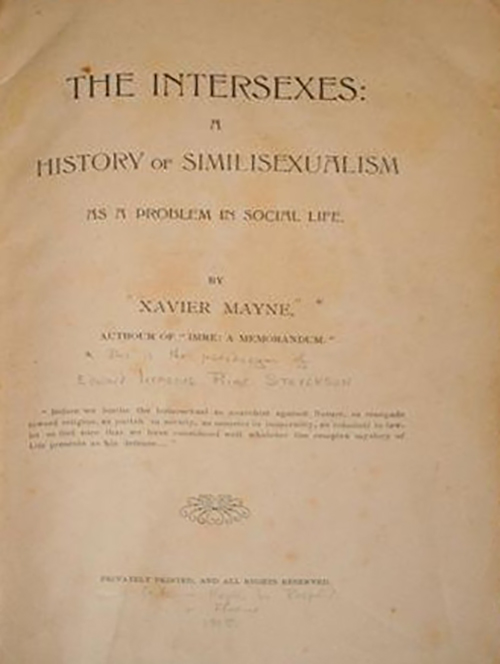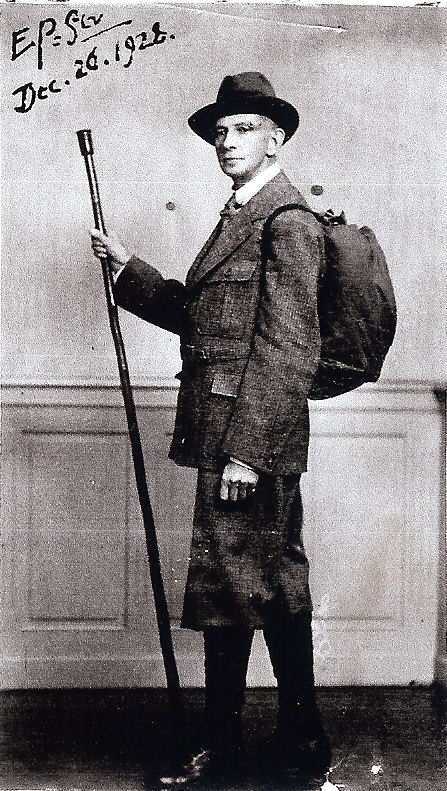Much about Xavier Mayne’s The Intersexes: A History of Similisexualism as a Problem in Social Life (ca. 1909) is mysterious and contradictory. Its author claimed to have written most of it around 1900, but the provenance of surviving copies and occasional citations within the text place it within the second half of the decade. It was definitely printed in Italy, but (unlike the author’s other self-published books) scholars have disputed whether in Florence, Rome, or Naples. The title itself suggests “similisexualism” might be medically suspect or socially deviant, but in reality the author’s intentions are more complex.
In Who Was That Man? A Present for Mr Oscar Wilde (1988), playwright Neil Bartlett describes coming across a copy of The Intersexes and initially assuming that the author was a homophobic sexologist aiming to “fix” the “problem in social life” identified in the subtitle. Instead, Bartlett was moved to find “a book written in the first person, a book written by a homosexual man about his own life and times.” As Bartlett noted, the scope of the book led its author to construct a kind of scrapbook of queer history and contemporary life: seemingly personal anecdotes, undated clippings from various newspapers, reading between the lines of famous blackmail cases. And, most relevant to my research, a great deal of gossip and anecdote.

Gossip has a long history as a source for queer subcultures and communities. Where formal knowledge is suppressed, taboo, or otherwise restricted, gossip can serve a variety of functions, from delineating membership in a group to subverting mainstream narratives. During the 1970s and 1980s, for example, resources like the interviews in Gay Sunshine and the Gay Book of Days preserved queer historical and celebrity gossip in printed formats, presenting chatty commentary and biographies of queer and rumoured-to-be-queer historical figures and tantalizing hints for readers looking for evidence of closeted queer celebrities in the present. It is easy as a historian to be dismissive of these sorts of media; they were often long on speculation and innuendo and short on citations, blurring the line between historical fact and fiction. For readers of these kinds of projects, however, gossip opens up new possibilities for interpreting the world in queer ways.
Despite The Intersexes’ vaguely medical title, its dedication to Richard von Krafft-Ebing, and sexological references, the book is far from a conventional work of early twentieth-century case studies. The opening pages explicitly reject the notion that medical literature should be the primary authority on the subject, suggesting that the titular “problem” is not homosexuality but public ignorance:
The following work was undertaken and completed several years ago, with the aim of offering to Anglo-Saxon readers … a general but condensed survey, for popular information, of the problem of homosexualism, similisexualism, urningism, inverted sexuality, uranianism, as it is variously termed. There is no large summary of the sort in English for intelligent lay-readers, whose interest in the topic is widely a specially serious one, nor easy sources of information for persons quite unacquainted with its extremely important bearings—social, legislative, psycho-pathological, and so on. […] The present book therefore essentially is one not written for active professional psychiaters, of any nationality. To such an aim it does not presume. It is addressed particularly to the individual layman, intelligently inclined to social sciences; whether he has has any immediate reason to study similisexuality, or none. If he have such personal reason, the book may be particularly useful to him.
Running to 642 pages (with some copies containing additional interpolated material of varying lengths), The Intersexes presents a history of homosexuality in all its forms in historical, literary, and artistic contexts.

Xavier Mayne was not a doctor at all, but the US music critic and novelist Edward Prime-Stevenson (1858-1942), a lifelong aficionado of queer gossip who played with the lines between fact and fiction. The pseudonym ostensibly sought to protect the wealthy, well-known Prime-Stevenson from speculation about his private life, but the pretense was thin to those with access to works published under either name. Works attributed to Prime-Stevenson cite Mayne (and vice-versa) and Mayne’s fictional characters crop up occasionally in Prime-Stevenson’s short fiction and writings on music. Gossip presented as fact in Mayne’s sexological work recurs in Prime-Stevenson’s music criticism, often with only the briefest efforts to hide its author’s deep knowledge of sexology and queer musical culture. And, while Prime-Stevenson’s citations of Mayne (including a dedication to him in one of his works on music criticism) occasionally imply that they are two separate people, he did not go through the effort to establish Mayne’s expertise outside of the two works published under that name. Perhaps tellingly, various biographical entries presumably authored and submitted by Prime-Stevenson for Who’s Who-style dictionaries allude to his conducting “studies in an obscure branch of psychiatric” under a pseudonym. Theodore Schroeder, a lawyer who owned the copy of The Intersexes now held by the Special Collections at the University of Wisconsin-Madison, wrote on the title page that Xavier Mayne was “(probably) E. I. Prime-Stevenson.”
A striking element of The Intersexes as a work of queer history is the argument that even seemingly non-queer artistic works could contain queer content or resonate with queer audiences. While today the act of “queering” as a verb is well-established, explaining what is queer about a text without decades of theory behind you presents incredible challenges. Now imagine doing so with a piece of instrumental music with only musical knowledge, rumors heard or overheard at concerts, and an understanding that existing published biographies and compilations of composers’ letters are at best opaque and at worst heavily censored. The brief section on composers and music in The Intersexes reflects Prime-Stevenson’s approach to queer musical meaning.
Composers present homosexual types; during either all their lives, or portion of them. The supreme secret of the noble-natured and moral Beethoven seems to have been an idealized homosexualism. In Beethoven’s sad latest days, can be traced a real passion for that unworthy nephew Carl; who, it is said, once sought to extort money from Beethoven, on threats to disclose an homosexual relationship! Beethoven’s beautiful sonata, Opus 111, in often called among German and Austrian Uranians, “The Uranian Sonata”, from some legendary “in-reading” of the work. The death of the brilliant and unhappy Russian composer Tschaikowsky has been affirmed (if denied with equal conviction) as a suicide, not a sudden illness, in consequence of terror of a scandal that hung over him—a relative being spoken of as the persecutor. Some homosexual hearers of Tschaikowsky’s last (and most elegiac) symphony, known as the “Pathetic” claim to find in it such revelations of a sentimental-sexual kind that they have nicknamed the work the “Pathic” Symphony. Brahms and the colossal Bruckner have been characterized as “the ultimate voices in a homosexual message by symphonic music”; even if one sub-consciously uttered.
To the musicologist or classical music fan in the 2020s—especially one familiar with queer history and the development of queer and feminist musicology—this passage appears convoluted, a mess of specific but unsourced biographical claims, suggestions of queer musical subtext, and allusions to popular gossip not present elsewhere. But what could this passage mean for Prime-Stevenson and his contemporaries? What did it mean to read—or hear—“revelations of a sentimental-sexual kind” in symphonic music?
Prime-Stevenson’s account of Tchaikovsky had been circulating for over a decade when The Intersexes appeared. References to the composer’s relationship with his nephew and rumors (now largely debunked) of suicide in connection with his Sixth Symphony (the Pathétique), resonate with biographer Rosa Newmarch’s objections to “sensationalist” stories of Tchaikovsky’s death. They also echo fictional conversations about Tchaikovsky and the Pathétique found in E.M. Forster’s novel Maurice (written largely during the 1910s and published posthumously in 1971), both fairly contemporaneous with The Intersexes.
The other composers and pieces mentioned in Prime-Stevenson’s account—none of whom are conventionally included in queer histories of music—are probably more surprising to the twenty-first century musicologist or classical music lover. Classical music fans are likely familiar with longstanding discussions of Beethoven’s heterosexuality in connection with the famous “Immortal Beloved” letter (or the 1994 film of the same name). Addressed to an unknown woman, ambiguously dated, and seemingly never delivered to its intended recipient, the document has provoked both scholarly debate and fictional speculation since the 19th century.
References to alleged queer gossip and “in-reading” here allow Prime-Stevenson to conflate elements of Tchaikovsky’s and Beethoven’s biographies: the idea of secret readings of the official biographical narratives, the focus on a potential sexual relationship between relatives and the connection between a composer’s sexuality and a specific piece. The association between the two composers is something of a recurring theme in Prime-Stevenson’s work, one that is perhaps more reflective of his own musical and biographical interests than the supposed “German and Austrian Uranians” he claims as sources. In Mayne’s novel Imre, the narrator Oswald describes “half-divining” his homosexuality as a child by listening to the “tone-autobiographies” of Beethoven and Tchaikovsky.
Similarly, Prime-Stevenson understands symphonies by Brahms and Bruckner (both long-time bachelors whose complicated relationships with women are traditionally established as major facets of their biographies) as having “sub-conscious” queer musical meanings for queer listeners that do not necessarily reflect their creators’ identities. The apparent quote “the ultimate voices in a homosexual message by symphonic music” appears unattributed, and one suspects it might be the voice of Prime-Stevenson himself (or, perhaps more generously, heavily adapted from private speculation among friends that of course went unrecorded).
My parenthetical here raises one of the persistent problems with establishing Mayne’s sources and musical authority. While Prime-Stevenson’s bona fides as a music critic are clear thanks to his international connections and extensive backlist of music and theatre columns, Mayne’s musical claims rely on a level of interpretation that by its nature consists primarily of secret reading (and listening) between the lines. Who are these “homosexual hearers” Prime-Stevenson imagined? While many of his specific musical claims appear fanciful (especially as regards Beethoven and Bruckner), he is not the only source on queer audiences for instrumental music in the early twentieth century and it is possible to piece together a broad, if piecemeal, outline of the queer musical environment in which Prime-Stevenson lived, worked, and listened.
One scene from the novel Maurice has the unmusical title character attending a performance of the Pathétique, where an old university friend delights in repeating scandalous gossip about the “Pathique et Incestuese” story behind the symphony. Prime-Stevenson’s sometime friend and colleague James Gibbons Huneker had his fictional conservative critic Old Fogy visit a New York City café in 1898, where a group of young men suggestively offer one another cigars and chat about Tchaikovsky’s death and scandalously present him as “the last word in music.” Even Rosa Newmarch, whose scholarly writings on Tchaikovsky carefully reject any hint of “sensationalism” or secret autobiographical message, presented a potential glimpse at her own queer concertgoing experience in the sonnet “The Symphony (Peter Ilich Tchaikovsky).” In that poem, an ungendered narrator experiences an overwhelming emotional sensation and holds hands with a female beloved at a Tchaikovsky concert in a moment that biographer Lewis Stevens’s suggests is inspired by Newmarch’s own relationship with Elizabeth “Bella” Simpson.
British suffragette, conductor, and composer Ethel Smyth adored Brahms’s music (although she later rejected his misogyny) to such an extent that Tchaikovsky considered it one of her “eccentricities” as an Englishwoman alongside wearing tweeds, hunting, and having a large dog as a pet. Incidentally, Smyth’s and Tchaikovsky’s separate recollections of one another make for an interesting glimpse into how various things commonly read as queer signifiers in biographies of individuals did and didn’t translate across languages and nations. Although Smyth did not overtly address her lesbian relationships in her memoirs and other public writings, she remarked sarcastically that she was sometimes better known for her “unfeminine” self-expression and political activities than for her music.
For Prime-Stevenson, the notion of listening for personal and idiosyncratic meanings in music was further developed in later privately printed revisions of his music criticism. His last known book, A Repertory of 100 Symphonic Programmes (ca. 1932/3), is a guide to record collecting and listening. Through a series of curated “programmes” (which read remarkably like our current playlists), he constructed attentive listening as akin to a ghostly, deeply personal message in sound from composer to audience member. While not all of Prime-Stevenson’s writing is overtly queer, his sense of self and community was clearly bound up in musical knowledge, gossip, and listening in ways that transcend accepted or acceptable musical biography or interpretation. Taken together with some of his readers, sources, and contemporaries, this scattered glimpse into real and fictional queer responses to instrumental music reflect the complexities of establishing how and where queer musical meanings developed, even within this limited sample of wealthy and upper-middle-class Anglophone concertgoers reacting to the same repertoire. This complexity remains an issue in intellectual climates where queer histories remain criticized for seemingly being ahistorical anachronistic readings of the past. There were people queerly thinking about music across history, but how and where do we find them? And what do we do when their readings do not necessarily align with our own or reflect categories and constructions that now seem illegible? Listening more carefully, more queerly, to figures like Prime-Stevenson and works like The Intersexes provides one way of considering queer historical projects across time.

Kristin Franseen (PhD Musicology, McGill) is a 2021-2023 FRQSC Postdoctoral Fellow in the Department of History, Concordia University, Canada. Her research centers on the place of identity, gossip, and fiction in the histories of musicology, music theory, and music biography. She tweets from @musicologygeek.

NOTCHES: (re)marks on the history of sexuality is licensed under a Creative Commons Attribution-NonCommercial-NoDerivatives 4.0 International License.
Based on a work at www.notchesblog.com.
For permission to publish any NOTCHES post in whole or in part please contact the editors at NotchesBlog@gmail.com




